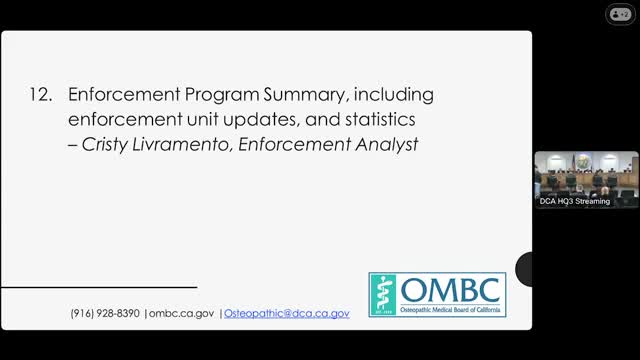Enforcement Unit Enhances Complaint Process and Analyst Communication at OMBC
November 16, 2024 | Osteopathic Medical Board of California, Other State Agencies, Executive, California
This article was created by AI summarizing key points discussed. AI makes mistakes, so for full details and context, please refer to the video of the full meeting. Please report any errors so we can fix them. Report an error »

The Osteopathic Medical Board of California convened on November 14, 2024, to discuss significant updates in their enforcement processes and the impact of recent staffing changes. The meeting highlighted the board's commitment to improving consumer protection and streamlining complaint handling.
Christie Libermento, an enforcement analyst, presented a detailed report on the board's enforcement activities. She noted that since the last meeting, the enforcement unit has implemented new processes, including an analyst introduction letter for every patient-related complaint. This letter provides complainants with direct contact information for their assigned analyst, allowing for more efficient communication and the opportunity to submit additional information at any time. Additionally, patients are now informed about the impact statement process, with brochures sent to guide them on how to write these statements.
The board reported an 18% increase in consumer-related complaints in the first quarter of the fiscal year compared to the previous year. While the board has successfully met its targets for initiating cases and completing investigations within set timeframes, challenges remain, particularly with cases referred to the Attorney General's office. The average time to complete these investigations has risen to 902 days, significantly above the target of 540 days, largely due to a backlog and the complexity of cases.
Board members discussed the implications of these delays, emphasizing the importance of timely action to protect consumers. They acknowledged that while the board is meeting most performance measures, the extended timelines for cases in the Attorney General's office are concerning. The board's goal is to file accusations well within the statute of limitations, but external factors, such as scheduling and communication with legal representatives, can complicate this process.
Public comments during the meeting underscored the positive reception of the board's recent staffing additions, which have enabled the initiation of complainant interviews before cases are closed. Consumer watchdog representatives expressed appreciation for the board's proactive measures and suggested further enhancements to the complaint notification process.
In conclusion, the Osteopathic Medical Board of California is making strides in improving its enforcement capabilities and consumer communication. However, the board faces ongoing challenges with case processing times, particularly in collaboration with the Attorney General's office. The board's commitment to consumer protection remains a priority as it navigates these complexities. Future meetings will likely continue to address these issues and seek solutions to enhance efficiency and responsiveness in enforcement actions.
Christie Libermento, an enforcement analyst, presented a detailed report on the board's enforcement activities. She noted that since the last meeting, the enforcement unit has implemented new processes, including an analyst introduction letter for every patient-related complaint. This letter provides complainants with direct contact information for their assigned analyst, allowing for more efficient communication and the opportunity to submit additional information at any time. Additionally, patients are now informed about the impact statement process, with brochures sent to guide them on how to write these statements.
The board reported an 18% increase in consumer-related complaints in the first quarter of the fiscal year compared to the previous year. While the board has successfully met its targets for initiating cases and completing investigations within set timeframes, challenges remain, particularly with cases referred to the Attorney General's office. The average time to complete these investigations has risen to 902 days, significantly above the target of 540 days, largely due to a backlog and the complexity of cases.
Board members discussed the implications of these delays, emphasizing the importance of timely action to protect consumers. They acknowledged that while the board is meeting most performance measures, the extended timelines for cases in the Attorney General's office are concerning. The board's goal is to file accusations well within the statute of limitations, but external factors, such as scheduling and communication with legal representatives, can complicate this process.
Public comments during the meeting underscored the positive reception of the board's recent staffing additions, which have enabled the initiation of complainant interviews before cases are closed. Consumer watchdog representatives expressed appreciation for the board's proactive measures and suggested further enhancements to the complaint notification process.
In conclusion, the Osteopathic Medical Board of California is making strides in improving its enforcement capabilities and consumer communication. However, the board faces ongoing challenges with case processing times, particularly in collaboration with the Attorney General's office. The board's commitment to consumer protection remains a priority as it navigates these complexities. Future meetings will likely continue to address these issues and seek solutions to enhance efficiency and responsiveness in enforcement actions.
View full meeting
This article is based on a recent meeting—watch the full video and explore the complete transcript for deeper insights into the discussion.
View full meeting
